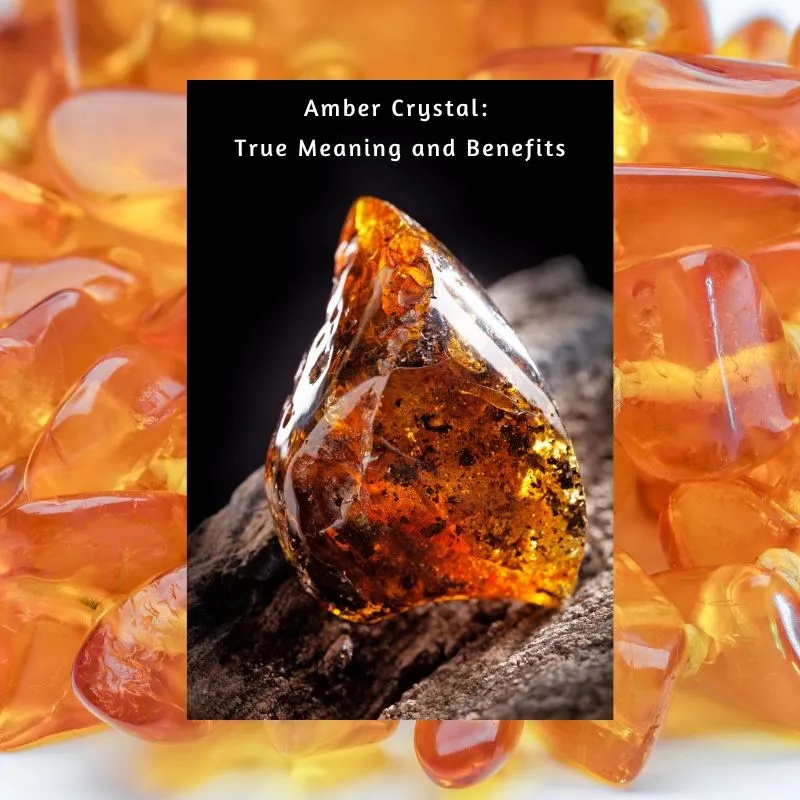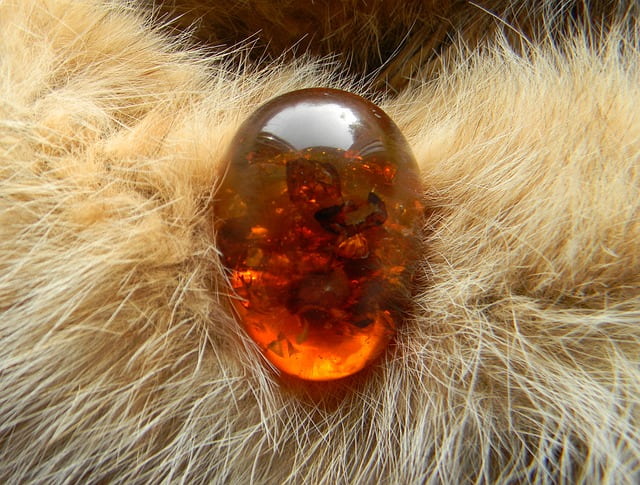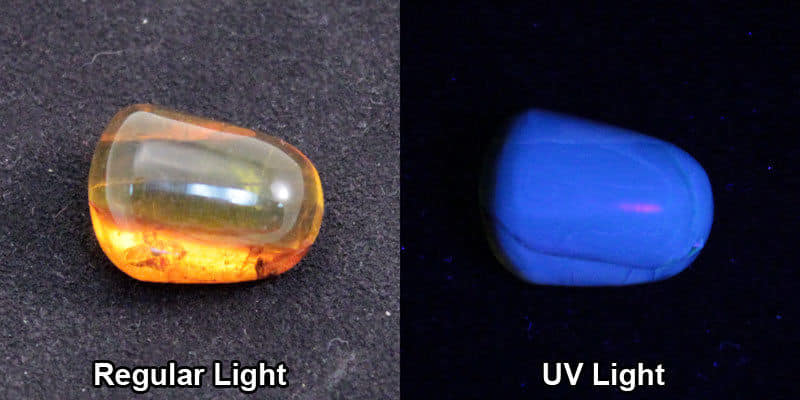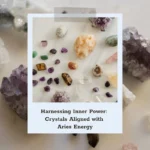
What is an amber crystal? Is there truth behind its meaning, benefits, and metaphysical healing properties? In this post, we will answer some of your most frequently asked questions about this majestic stone, and even teach you how to spot a real amber from a fake one. Let’s get it on!
Amber Crystal Meaning: An Overview
Before we dive into the amber crystal meaning, it’s important to know what amber is in the first place. One of the misconceptions about amber is that it is a gemstone- it is not. This is a thick resin that came out of prehistoric trees from millions of years ago. Scientists have discovered that they would secret this resin either to heal from their own barbs that came from diseases and insect attacks or, as a form of excretion to clean their systems.
Either way, this hardened resin differs from a tree sap, since it is way thinner, and a sweet, watery liquid that a tree lets out—more like where your maple syrup comes from. Amber on the other hand is a hardened resin found on prehistoric trees whose remnants are all over the globe.
There are three main deposits where you can find the amber crystal. The Baltic amber, the Dominican Republic, which is very famous for its unique tropic inclusions. There’s also the Burmese amber, which is unfortunately in a comfort zone. Looking closely, you will see its diverse fossil inclusions burrowed deep within. The reason why it is sought after is because of its prehistoric inclusions like fur, insects, feathers, and even little leaves and sticks, which tells a lot about what happened in our prehistoric past.
Amber Crystal: Amber Metaphysical Properties

Do amber healing properties really exist? Yes, they do! Amber can open and balance a person’s solar plexus chakra, also known as your emotional center. It does the same thing with the sacral chakra which is responsible for an individual’s creative and sexual energies. This also allows you to see the humor in everyday life, so no matter how bad things get, you won’t find yourself taking them so seriously. You’ll be able to enjoy life and take it for what it is, including the good, the bad, and even the ugly.
Nature lovers will also be ecstatic to know that amber crystal is a great way to connect with history and nature. So not only will this help keep you grounded in the here and now, but it will also make you appreciate your roots and everything that contributed to your present. And as far as amber crystal benefits are concerned, it improves our decision-making, strengthens our immune system, and boosts our memory.
Additionally, amber’s energy is believed to facilitate a deep sense of well-being and inner peace. By aligning with its natural vibrations, you may experience enhanced emotional resilience and a more optimistic outlook on life. Amber’s connection to ancient wisdom and the earth’s vitality can also inspire a profound sense of personal growth and spiritual development. This makes it not only a tool for physical healing but also a companion in your journey toward emotional and spiritual fulfillment.
Apart from these, it is also believed to aid with relief from anxiety, depression, and disconnectedness. It also helps in healing internal organs such as the spleen, kidneys, stomach, liver, bladder, and gallbladder. Amber can also draw out infections while integrating a strong, protective barrier around your body.
Amber Crystal: Testing for Authenticity
Now, it’s virtually impossible to benefit from amber crystal properties if you possess a fake one, right? So aside from knowing the various amber crystal meanings and uses, it’s equally important to learn how to test for its authenticity and spot the real ones from the phonies. Here are several ways to do that.
The Acetone Test
Amber will not dissolve in alcohol, unlike copal. You can use a little nail polish remover or acetone if what you have is a copal or another amber substitute. A real amber will not be affected by the substance. However, it is copal, it turns sticky and begins to dissolve.
This is because copal, often used as a cheaper substitute for amber, has different chemical properties and is more prone to reacting with solvents. By using acetone, you can easily identify copal as it will show visible signs of degradation, such as stickiness or dissolution. This test is particularly useful for those who want a quick and accessible way to verify their amber without needing specialized equipment.
The Scratch Test
A real amber is scratched by a pin, while glass and the majority of plastics will not. If it’s copal, it will be scratched even more easily using a pin.
This test works because amber has a unique hardness compared to other materials. Genuine amber is relatively soft, which makes it more susceptible to scratching with a pin. On the other hand, glass and most plastics have higher hardness levels, so they resist scratches more effectively. This difference in hardness can help you determine whether you have real amber or a different material.
The Weight Test
Amber is not heavy like glass, rather, it’s lightweight, just like plastic. When clicking it against your teeth, it has to sound like plastic and not like the heavy clinking sounds of glass or stones.
This test relies on the fact that amber is less dense than glass and many other materials. Genuine amber has a lighter weight and a distinctive sound when tapped, similar to plastic. By comparing the weight and sound of the amber piece to that of glass or stone, you can assess its authenticity.
The UV Light Test
When put under UV light, amber will display fluorescent colors. Other materials are unlikely to do this under UV light. However, this is not 100% guaranteed, so you may need to conduct other tests to completely rule them out in case they glow.
This test exploits the unique ability of amber to fluoresce under UV light, which is a result of its chemical composition. Amber will emit a yellow or greenish glow, which can help identify it among other materials. However, some synthetic or treated materials might also fluoresce, so it’s advisable to use this test in conjunction with others to confirm the authenticity of the amber.
The Salted Water Test
When put on heavily salted water, amber floats, and when it’s in plain water, it sinks. Do this by dissolving 1/4 cup of salt in 2 cups of warm water. Drop the stones in the salt water then mix to see if they will either sink or float. Use the stones that are not set on jewelry to do this test.
Amber has a lower density than heavily salted water, causing it to float, whereas in plain water, it will sink due to its greater density compared to water alone. This method is practical for distinguishing amber from other materials with similar appearance but different densities.
The Static Energy Test
Amber has become widely known for its static electricity properties. To do this, vigorously rub the stone with a cloth and try picking up tiny pieces of hair, scraps of paper or dust with it, and it will attract them and stick to it like a magnet. The majority of plastics won’t produce static electricity. On the other hand, the copal may turn sticky after such rubbing.
This test utilizes amber’s well-known ability to generate static electricity, which is a key feature distinguishing it from many other materials. By rubbing the amber, you charge it with static electricity, allowing it to attract small particles. This characteristic is not typically found in most plastics or synthetic materials, making it a useful test for identifying genuine amber.
The Hot Needle Test
When burned, amber will smell heavily like pine, while plastic will smell like, well, burnt plastic. Some people also burn amber to it as incense. At any rate, test your stone using a hot needle. If your needle goes in effortlessly, it’s more likely to be copal. However, if you feel significant resistance, it is more likely to be genuine amber.
When heated, amber emits a natural pine-like aroma due to its organic origins, while plastics release a synthetic, unpleasant odor. The resistance you feel when inserting a hot needle into the stone helps differentiate between amber and copal, as copal is softer and more easily penetrated.
The Heat Conductor Test
An amber stone is not a good heat conductor, so it’s supposed to feel warm to the touch. Other crystals and glass on the other hand feel cold during contact. This is the case because amber does not absorb body heat the way other crystals do.
This test relies on the thermal conductivity of the material. Since amber has a low thermal conductivity, it retains body heat and feels warm when held. In contrast, materials like glass and many other crystals have higher thermal conductivity, so they feel cool to the touch. This difference in heat retention can help you identify amber among other materials.
The Melting Test
Unlike copal, amber possesses a high melting point of 570 degrees Fahrenheit. And even then it will not disintegrate into liquid form, it will simply decompose like your normal incense. Try doing this with copal at a much lower temperature and see it melt very quickly.
This test distinguishes amber from copal by observing how each material responds to extreme heat. Amber’s high melting point means it will decompose rather than melt into a liquid, which is typical for its composition. Copal, on the other hand, has a lower melting point and will liquefy much faster under similar conditions. This test provides a clear comparison of thermal behavior between amber and its substitutes.
Amber Crystal Care Instructions

Now that you know this much about amber spiritual properties, metaphysical and healing properties and other benefits, you will hopefully be inspired to treat your amber with much love and care.
Authentic amber contains very soft material, so you must handle it with utmost care. Because it is very sensitive and can be easily scratched by metals or harder gems, make sure it does not have any contact with them.
For cleaning, use a soft cloth with a little water. Do not clean your amber jewelry using alcohol or other solutions because it can leave some ugly, white, powdery stain on your stone.
Handling Your Amber
- Store Separately: Keep your amber jewelry or crystals in a soft cloth pouch or separate compartment in your jewelry box to avoid contact with harder materials.
- Avoid Contact with Chemicals: Keep amber away from harsh chemicals, including perfumes and household cleaners, which can damage its surface.
- Wear Carefully: When wearing amber jewelry, avoid situations where it might come into contact with hard surfaces or be subject to rough handling.
Cleaning Your Amber
- Use a Soft Cloth: For routine cleaning, use a soft, damp cloth to gently wipe the surface of your amber. Avoid using abrasive cloths that might scratch the surface.
- Avoid Soaking: Do not soak amber in water or any cleaning solutions. Prolonged exposure to water can weaken the stone and potentially cause damage.
- Dry Thoroughly: After wiping, gently dry the amber with a clean, soft cloth to prevent moisture from lingering on the surface.
Additional Care Tips
Amber is a natural and delicate material, so it’s important to take extra precautions to preserve its beauty and integrity. Regularly check your amber jewelry for signs of wear and ensure that it is stored properly. If you notice any changes or damage, consider consulting a professional jeweler who specializes in amber for advice or repairs.
By following these care instructions, you can help ensure that your amber remains in beautiful condition and continues to provide its unique spiritual and healing benefits for years to come.
Final Thoughts On the Amber Crystal Meaning
Why should you appreciate your amber crystal now more than ever? Aside from the obvious reason that it makes stunning jewelry that can be worn for long periods around the throat and wrist, it can also purify your body, mind, and spirit. It’s super lightweight compared to other crystals and gemstones which makes it super comfortable for daily wear.
People who have been using amber for years love how it can balance their Yin and Yang, block negativity, and cleanse their chakra. After absorbing the negative energy, it will then transmute them into positive forces to help the individual achieve balance. No wonder this crystal is heavily sought out because it means beauty, protection, and healing all in one.





